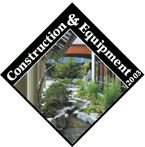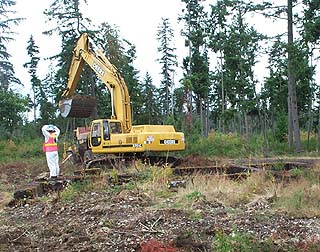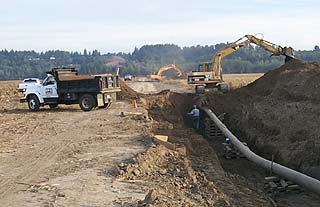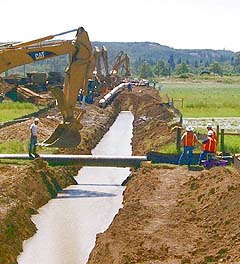
Surveys
Awards
DJC.COM
March 27, 2003
Look out below when starting site work
Historical Research Associates

Thompson |
Archaeologists don’t always find all of the sites in advance of project construction — for example, some may be deeply buried under sediments in a river flood plain. That’s why archaeologists prepare a set of procedures about where archaeological monitoring is needed and what will be done if construction encounters historic or prehistoric artifacts, or human remains.

Photos courtesy of Historical Research Associates Construction workers at the DuPont Works site found $10,000 stuffed in a garbage can near the location. |
In addition to prehistoric fire hearth features or house-pits, the archaeological deposits can include old trash dumps, with artifacts showing what the local occupants from various time periods used and discarded, and might include the remains of early houses or other structures.
Archaeologists often provide environmental inspectors and construction supervisors with project maps showing the sensitivity of construction areas for containing archaeological remains.
At the construction site for the new Tacoma Narrows Bridge, HRA’s archaeologists have designated parts of the corridor red to show where archaeological monitoring is needed and green for areas that don’t. The environmental inspectors coordinate the work schedule to ensure that an archaeologist is present when monitoring is needed.
Engineers have designed the placement of the new bridge piers to avoid damaging the submerged remains of “Galloping Gertie,” the earliest Tacoma Narrows bridge, which was destroyed by a windstorm in November 1940. HRA’s archaeologists will work with the engineers to document that construction does not damage the submerged remains, which are considered to be an important historical site.

When this pipeline along the Cowlitz River was lowered, archaeologists monitored the work after an Indian burial site was found. |
When project construction begins, archaeologists often train construction personnel on the procedures for archaeological monitoring: how to recognize artifacts and what to do if they are encountered.
On the Northwest Pipeline Corp.’s Grays Harbor gas pipeline, HRA archaeologists placed flagging tape at areas requiring monitoring, so that inspectors could call them as needed. Finds there of a prehistoric obsidian (volcanic glass) stone tool and historical artifacts from an early barn caused archaeologists to divert construction activities briefly while consulting with the State Archaeologist and Chehalis Indian Tribe regarding treatment.
After quickly mapping the sites and collecting samples, the archaeologists were able to clear the area to resume construction. Later analysis showed that the obsidian artifact had come from a source in central Oregon, illustrating prehistoric trade.
Job-site safety is always a concern on construction sites and archaeologists have learned a lot about the required safety clothing, equipment and where to walk so that the equipment operators can see them.
Sometimes archaeologists need to receive training for working in a hazardous materials environment. The former DuPont Works site, where explosives were made, is in an area where Nisqually Indian and early historic traders’ activities occurred. Soil remediation and archaeological activities there require archaeological monitors to follow strict safety procedures.
Construction could encounter unmarked burials — sometimes of prehistoric Indian people. Protecting the location from further disturbance and keeping it confidential is extremely important.

Archaeologists on this Northwest Pipeline Corp. project in Grays Harbor diverted construction briefly to consult with tribal and state officials about the discovery of prehistoric tools. |
When unanticipated discoveries like these are made, the archaeologists coordinate with the Washington State Historic Preservation Officer, the affected Indian tribes and project officials to ensure that the proper procedures are followed to deal respectfully with the remains and facilitate construction activities.
Improper treatment of Indian burials at the construction of a sewage treatment facility for the city of Blaine in 1999 resulted in criminal investigations and court cases involving millions of dollars.
Archaeological monitoring took place along the Cowlitz River in southwestern Washington when an existing petroleum products pipeline needed to be lowered. Agricultural activities near the line had reduced the necessary depth of soil above the pipeline and also exposed an Indian burial. This raised the concern that pipeline lowering could disturb other human remains or artifacts that might be located nearby. Archaeological monitoring during pipeline lowering was able to confirm that no other remains were present.
Archaeologists often are asked if they are “finding any treasure” when they are excavating a site and they almost always have to answer “No.”
In a dramatic turn of events last October, construction workers at a site in the city of DuPont encountered a plastic garbage can containing up to $10,000 in coins and small bills that may have come from an arcade robbery.
Our archaeologists would have enjoyed the find, but unfortunately they were not present. They had evaluated the area as a recent earthen feature that would not contain sufficiently old historic-period or prehistoric archaeological remains and therefore was not in need of monitoring.
Gail Thompson, Ph.D., is a vice president at Historical Research Associates’ Seattle office. The company provides a variety of archaeological and historical services. Thompson can be reached at (206) 343-0226 or by e-mail at thompson@hrassoc.com.
Other Stories:
- Washington’s construction forecast remains hazy
- The equipment dilemma: buy or rent?
- How to defuse skyrocketing insurance costs
- Software streamlines vehicle maintenance
- Don’t let erosion wash away your profits
- Plywood sheets get new stripes
- Send your team to ‘spring training’
- Smoothing out the construction process
- Success times 10 — follow these leaders
- Students learn to handle the heavy metal
- What is your construction company worth?
- Learning a lesson from booming China
- Bringing the steel detailer into the design process
- Speech Making 101 for contractors
- Going to a happy place — work!
- Passing the ownership baton
- 3 ways to make sure you get paid
Copyright ©2009 Seattle Daily Journal and DJC.COM.
Comments? Questions? Contact us.